Introduction
The aerospace industry faces complex challenges: soaring operational costs, stringent safety standards, and exponential data growth from aircraft and satellites. AI is emerging as a transformative enabler: automating inspections, optimizing routes, and even powering autonomous systems. This guide explores how AI is reshaping aerospace from design and maintenance to air traffic management and defense.
What is AI and Why Does It Matter in Aerospace?
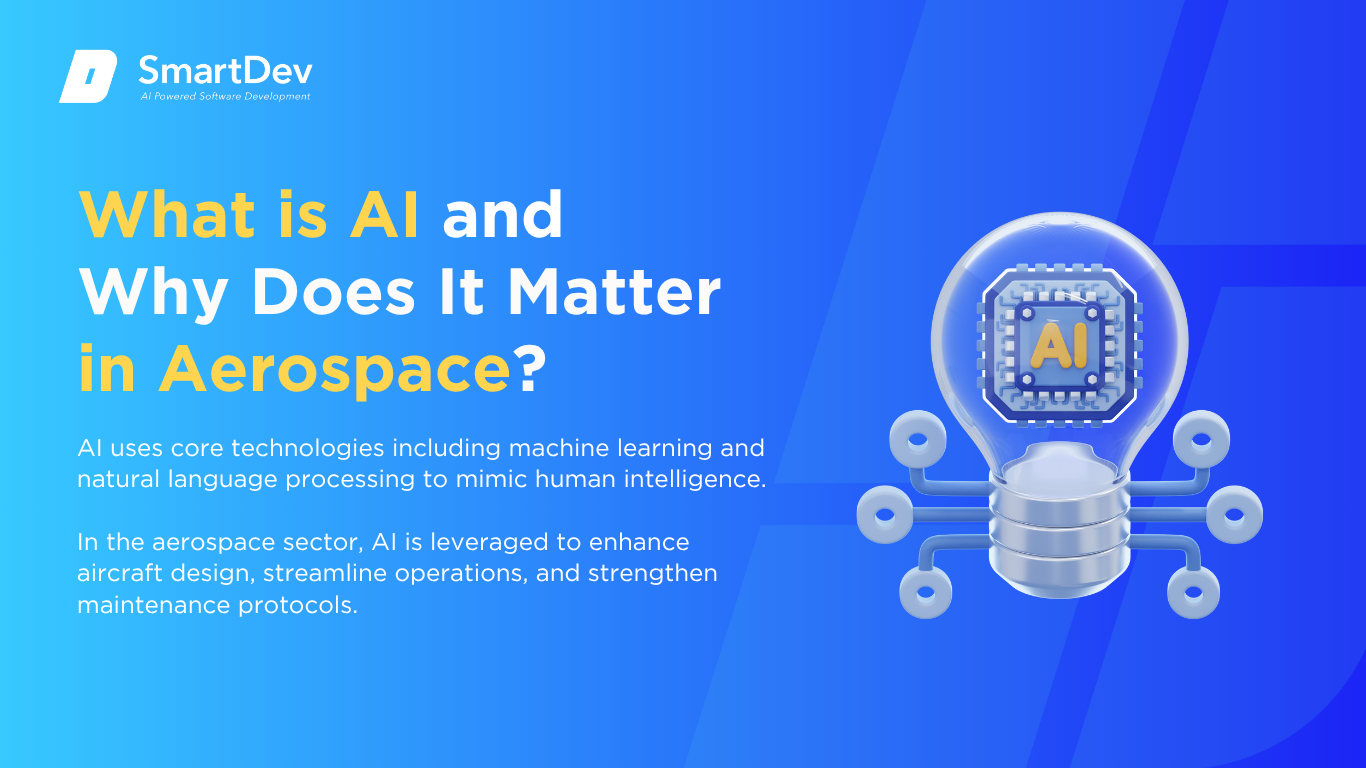
Definition of AI and Its Core Technologies
Artificial Intelligence (AI) encompasses technologies that allow machines to perform tasks involving learning, reasoning, and decision-making – traditionally the domain of humans. Key technologies such as machine learning, computer vision, and natural language processing enable systems to process large datasets, identify patterns, and make real-time decisions. These capabilities form the foundation for advanced automation and intelligent analysis across industries.
In the aerospace sector, AI is leveraged to enhance aircraft design, streamline operations, and strengthen maintenance protocols. Applications range from optimizing aerodynamics through AI-driven simulations to predicting component failures before they occur. By embedding intelligence into systems and processes, aerospace organizations can improve safety, efficiency, and innovation.
Explore how core AI concepts work in our introductory guide designed to make complexity clear and practical.
The Growing Role of AI in Transforming Aerospace
AI is increasingly central to accelerating and enhancing the aircraft design process. Intelligent systems can simulate and evaluate thousands of design variations with remarkable speed and precision. Methods such as reinforcement learning and Bayesian optimization allow engineers to fine-tune aerodynamic performance and structural efficiency early in development.
In aerospace manufacturing and maintenance, AI significantly improves quality control and structural monitoring. Advanced computer vision and sensor-based systems detect subtle defects in composite materials, including micro-cracks and delamination, that are often missed by traditional inspections. These capabilities reduce manual labor, enhance safety, and minimize downtime.
Autonomous technologies in aerospace are advancing rapidly through AI-driven navigation and decision-making. Systems onboard unmanned aerial vehicles, autonomous aircraft, and planetary rovers can interpret real-time data to avoid obstacles and respond to dynamic conditions. This enables more reliable and efficient autonomous operations in both terrestrial and space environments.
Key Statistics and Trends Highlighting AI Adoption in Aerospace
The global AI market in aerospace and defense is projected to reach US $24.3 billion by 2030, reflecting a CAGR of approximately 6.2 %. The AI & Robotics Software segment is also set to grow at 7.8% CAGR over the analysis period. Such growth underscores sustained investment in AI-driven hardware and software for defense and aviation systems.
Another estimate places the AI in aerospace and defense market at US $22.45 billion in 2023, with a CAGR of 9.8 % through 2030. North America leads adoption, accounting for over 41 % of market share, driven by both government and commercial investment. The U.S. alone contributed more than US $10.4 billion in 2024, with growth near 10 % annually.
Key drivers include AI applications in predictive maintenance, air traffic management, and autonomous systems. Predictive analytics is helping reduce unscheduled maintenance, improving aircraft readiness and cost efficiency. In 2024, global venture funding in defense-related AI platforms reached US $31 billion, a 33 % increase over the previous year.
Business Benefits of AI in Aerospace
AI is delivering measurable impact across the aerospace value chain, addressing core pain points in design, operations, and maintenance. By embedding intelligence into key systems, companies can reduce costs, improve safety, and unlock new efficiencies.
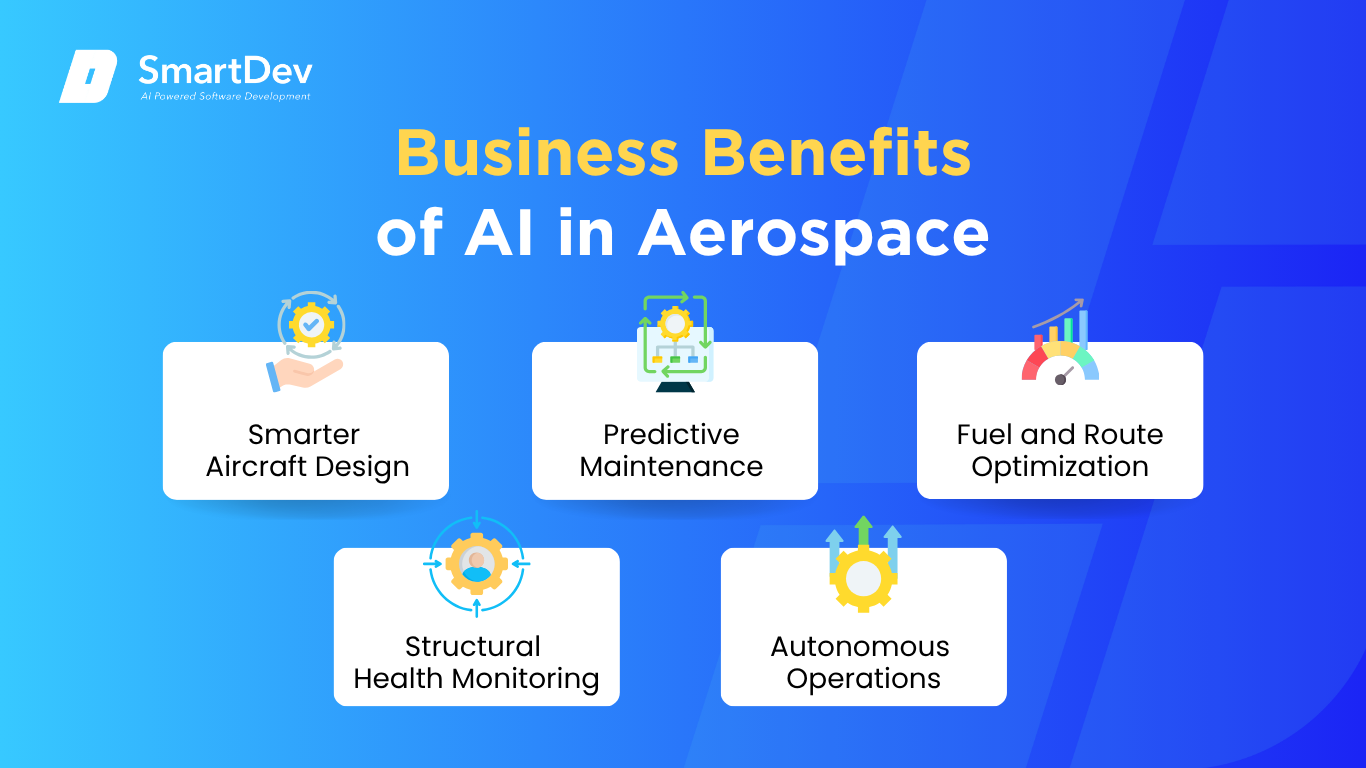
1. Smarter Aircraft Design
AI accelerates aircraft development by simulating and analyzing countless design variations in a fraction of the time. Engineers can optimize performance elements like aerodynamics and structural layout earlier in the design process. This reduces reliance on physical prototypes, saving both time and cost.
The ability to explore unconventional configurations quickly supports innovation and product differentiation. Faster iteration leads to shorter development cycles and earlier market entry. In a highly competitive industry, this design agility is a key advantage.
2. Predictive Maintenance
AI systems analyze real-time data from engines and components to identify faults before they become critical. GE Aerospace reports that these tools detect maintenance issues up to 60 % earlier, improving planning and reducing disruption. Early detection also extends asset life and ensures safer operations.
Fewer unscheduled repairs mean less downtime and more efficient use of maintenance crews. Airlines and defense fleets benefit from improved aircraft availability and lower lifecycle costs. Over time, predictive maintenance transforms reactive repair into proactive asset management.
Explore how our AI-powered solutions for manufacturing drive efficiency, predictive maintenance, and intelligent automation – applicable across aerospace and industrial sectors.
3. Fuel and Route Optimization
AI enhances flight planning by factoring in real-time variables like weather, traffic, and aircraft performance. Qantas cut fuel consumption by 2%, saving around $92 million annually, through AI-optimized routing. These improvements also reduce emissions and align with sustainability targets.
Efficient routing boosts on-time performance and reduces pilot workload. Airlines gain cost savings while also meeting regulatory and environmental expectations. As AI models evolve, these optimizations will become even more precise.
4. Structural Health Monitoring
AI-powered sensors embedded in aircraft continuously monitor structural integrity. They detect subtle issues like micro-cracks or stress fractures before they affect safety. This allows for targeted repairs and fewer manual inspections.
Automated health monitoring improves reliability while lowering inspection costs. By addressing small issues early, operators avoid major overhauls and unscheduled downtime. The result is safer, more efficient fleet management.
5. Autonomous Operations
AI enables drones, spacecraft, and other autonomous systems to navigate and make decisions independently. In satellite assembly, AI-guided robotics now achieve over 95 % accuracy in part placement, improving efficiency. For UAVs, AI manages real-time navigation and obstacle avoidance.
In air traffic management, AI helps optimize flight paths and reduce congestion by analyzing live airspace and weather data. This improves safety and reduces controller workload. As air traffic increases, AI will be essential for maintaining system efficiency and safety.
Explore how AI boosts productivity and reduces waste in real-world scenarios in our guide on unlocking operational efficiency with AI.
Challenges Facing AI Adoption in Aerospace
Despite its promise, AI implementation in aerospace remains complex due to technical, regulatory, and organizational hurdles. Overcoming these challenges is essential to realizing the full value of intelligent automation in high-stakes environments.

1. Regulatory Hurdles
Aerospace is governed by strict safety and certification standards that AI systems must meet. Regulatory frameworks like DO-178C and DO-254 require systems to be fully explainable and reliable in all scenarios. Many AI models, especially deep learning algorithms, lack the transparency needed to pass these evaluations.
As a result, applying AI to safety-critical functions remains limited. Developers must invest heavily in model explainability and validation. Without certification, AI applications are often confined to non-critical support roles.
Aerospace systems must meet strict standards – see how AI model testing ensures reliability in this detailed guide.
2. Fragmented and Incomplete Data
AI’s effectiveness depends on large volumes of clean, structured data, yet much aerospace data is siloed across legacy systems. Sensor data, maintenance logs, and design files often lack standard formats and are difficult to integrate. This fragmentation slows model training and reduces the accuracy of predictions.
Building unified data pipelines requires significant investment in IT infrastructure and cross-department coordination. Aerospace organizations must also enforce data governance policies to ensure consistency. Without high-quality inputs, even the most advanced AI tools will deliver poor outcomes.
3. Trust and Human-AI Interaction
AI adoption in aerospace is often constrained by a lack of trust among engineers, pilots, and regulators. These stakeholders must understand and validate AI decisions, especially in mission-critical settings. Black-box models that offer no clear reasoning create hesitation and resistance.
To overcome this, AI systems must be designed with transparency and human oversight in mind. Training programs should focus on integrating AI into workflows rather than replacing human expertise. Building confidence in AI is as much a cultural shift as a technical one.
4. High Implementation Costs
Deploying AI in aerospace requires not only advanced software but also specialized hardware that meets rigorous durability and safety standards. Developing and certifying these systems adds significant upfront costs. Additionally, ROI may take years to materialize, making executives cautious.
Budget constraints are especially tight in defense and commercial aviation, where procurement cycles are long. Without a clear business case and phased rollout plan, AI projects risk being shelved. Cost remains a primary barrier to scaling adoption.
5. Workforce Readiness
Successfully integrating AI demands a workforce that understands both aerospace systems and data science. Many organizations face talent gaps in AI skills, particularly among technical staff and frontline operators. Without training, employees may resist new tools or misuse them.
Reskilling programs are essential but require time and organizational commitment. Leaders must also communicate the value of AI to reduce fear and promote collaboration. A prepared workforce is key to unlocking AI’s full potential in aerospace.
Specific Applications of AI in Aerospace

1. Predictive Maintenance
AI-powered predictive maintenance addresses the longstanding challenge of unexpected component failures in aerospace systems. Traditional maintenance models rely on routine schedules or reactive fixes, leading to inefficiencies and downtime. With predictive maintenance, AI analyzes telemetry data from engines, hydraulics, and avionics to detect patterns and predict failures before they occur.
The system typically uses machine learning models such as anomaly detection, regression trees, and neural networks trained on historical sensor and maintenance data. These models assess vibration, pressure, temperature, and other operational metrics to anticipate degradation trends. The AI then issues proactive maintenance alerts, enabling technicians to intervene before issues escalate.
Predictive maintenance improves operational efficiency, aircraft availability, and cost savings by reducing unplanned maintenance and extending component life. Airlines benefit from fewer delays, better fleet utilization, and improved passenger experience. Challenges include ensuring data quality, integrating across systems, and regulatory compliance.
Real-world example:
GE Aerospace implemented predictive maintenance across its jet engine programs using AI and digital twin technology. The platform monitors real-time sensor data and simulates engine behavior to identify anomalies early. This resulted in 60% earlier detection of failures and reduced unscheduled engine removals by 33%.
2. Autonomous Visual Inspection
Autonomous visual inspection automates the labor-intensive process of aircraft exterior inspections using drones or robotic systems. These platforms capture high-resolution images and laser scans of an aircraft’s surface, significantly reducing inspection time. AI algorithms then analyze the imagery to detect cracks, corrosion, dents, and paint damage.
The technology relies on convolutional neural networks and 3D model comparisons to accurately identify defects. The AI compares visual data against historical records and CAD models to flag irregularities. It generates detailed inspection reports, which are used to plan repairs and ensure regulatory compliance.
This application enhances consistency, reduces human error, and accelerates turnaround times. Inspections that once took days can now be completed in hours, increasing aircraft availability. Challenges include ensuring safe drone navigation, system calibration, and integration with maintenance databases.
Real-world example:
Airbus and Donecle developed an AI-powered drone inspection system capable of scanning an entire aircraft in less than an hour. The drone captures high-resolution imagery and uses AI to detect surface anomalies automatically. The system is now in use by airlines like Air France–KLM, significantly reducing inspection times and improving defect detection accuracy.
3. Flight Route & Fuel Optimization
Flight route and fuel optimization is a key AI application that addresses rising fuel costs and environmental impact. AI systems analyze vast datasets, including weather forecasts, air traffic, aircraft performance, and payloads, to identify the most efficient flight paths. By dynamically adjusting routes, these systems help airlines save fuel and reduce emissions.
These solutions typically use machine learning algorithms and predictive analytics to evaluate multiple route scenarios. They simulate outcomes based on different constraints and continuously refine models using real-time data. Integrated with flight management systems, the AI provides decision support to pilots and dispatchers.
The benefits include lower fuel consumption, reduced carbon footprint, and improved operational resilience. Airlines also gain financial savings and increased schedule reliability. However, success depends on accurate data, integration with existing systems, and pilot acceptance.
Real-world example:
Qantas developed the “Constellation” AI platform to optimize flight routes based on live operational data. The system accounts for weather, airspace, and aircraft performance to suggest fuel-efficient routes. It has delivered a 2% improvement in fuel efficiency, saving the airline approximately $92 million annually.
4. Integrated Vehicle Health Management (IVHM)
IVHM provides a holistic approach to monitoring and maintaining aircraft systems by integrating data across various subsystems. AI consolidates sensor data, maintenance logs, and operational history into a unified health profile. It then applies machine learning to detect patterns, anomalies, and potential failure points.
Technologies used in IVHM include Bayesian inference, neural networks, and fuzzy logic to evaluate system performance in real time. The AI processes data from avionics, propulsion, and structural sensors to deliver comprehensive diagnostics. Maintenance teams receive prioritized alerts and recommendations for inspections or part replacements.
Strategically, IVHM enhances reliability, safety, and cost-effectiveness by optimizing maintenance cycles and reducing lifecycle costs. It supports compliance with aviation safety standards and improves asset utilization. Challenges involve integrating legacy systems and managing vast volumes of heterogeneous data.
Real-world example:
Boeing and Cranfield University partnered to implement IVHM on commercial aircraft, focusing on structural integrity monitoring. The AI system uses probabilistic models to identify components at risk of fatigue or failure. This approach enabled more accurate maintenance scheduling and extended component service life.
5. Air Traffic Control & Traffic Management
AI in air traffic control (ATC) improves safety and efficiency by assisting controllers with complex decision-making tasks. AI systems process radar data, ADS-B signals, and voice communications to detect potential conflicts and optimize sequencing. These tools help manage growing air traffic volumes without increasing human workload.
Machine learning and natural language processing (NLP) enable the systems to understand controller-pilot interactions and suggest optimal routing solutions. AI algorithms predict traffic flow, weather disruptions, and runway occupancy to support proactive planning. The systems are often integrated as decision support tools rather than full automation.
Operationally, AI-enhanced ATC reduces delays, improves runway utilization, and increases situational awareness. These benefits are critical as global air traffic continues to rise. Safety remains paramount, requiring robust testing and human-in-the-loop protocols.
Real-world example:
Searidge Technologies developed AIMEE, an AI-based platform used at major airports like Heathrow. AIMEE analyzes video and radar data to assist controllers with aircraft sequencing and conflict detection. It has improved efficiency and reduced taxi times for over 40,000 monitored flights.
6. Autonomous Flight Control & Safety Systems
AI-based flight control systems use deep reinforcement learning (DRL) and sensor fusion to perform autonomous navigation, takeoff, and landing. These systems learn optimal control policies through simulation and apply them in real-time flight scenarios. They are designed to support or even replace human pilots in certain conditions.
The systems rely on inputs from GPS, IMUs, airspeed indicators, and terrain sensors. AI continuously evaluates aircraft states and adjusts control surfaces to maintain stability and trajectory. Safety features include redundancy, fault detection, and real-time decision-making capabilities.
Strategically, autonomous flight control reduces pilot workload and enhances safety during emergencies. It supports unmanned operations and urban air mobility initiatives. Regulatory certification and explainability remain key hurdles to widespread adoption.
Real-world example:
Aurora Flight Sciences, a Boeing subsidiary, developed an autonomous flight system capable of managing all flight phases without human input. Trained with reinforcement learning, the system demonstrated successful autonomous flights under DARPA’s ALIAS program. This technology is a major step toward pilotless air cargo and future autonomous passenger aviation.
Need Expert Help Turning Ideas Into Scalable Products?
Partner with SmartDev to accelerate your software development journey — from MVPs to enterprise systems.
Book a free consultation with our tech experts today.
Let’s Build TogetherExamples of AI in Aerospace
AI in aerospace is already delivering measurable impact across operations, maintenance, and flight optimization. These real-world examples illustrate how leading organizations are leveraging AI to drive tangible results.
Real-World Case Studies
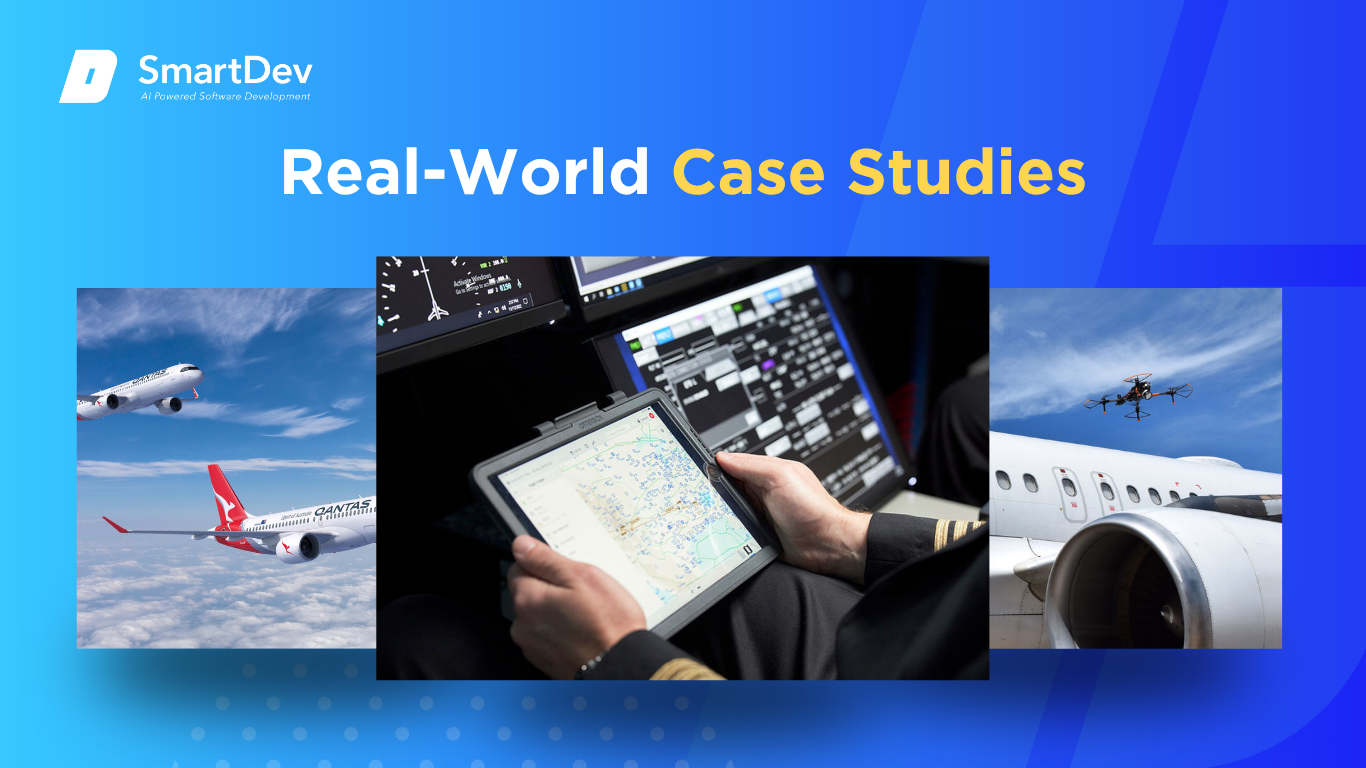
1. GE Aerospace: Predictive Engine Health Monitoring
GE Aerospace implemented AI-driven predictive maintenance across its engine fleets to anticipate mechanical failures before they occur. Using real-time sensor data and digital twin models, GE’s system evaluates engine health and simulates performance under various conditions. This proactive approach enables technicians to service engines only when needed, significantly reducing operational interruptions.
The solution, developed with Palantir Foundry, allowed GE to detect engine issues 60% earlier and cut unscheduled engine removals by 33%. This translates into improved mission readiness and cost savings in both commercial and military fleets. The initiative has also enhanced parts forecasting, reducing excess inventory and improving logistics efficiency.
2. Airbus: AI-Powered Drone Inspection with Donecle
Airbus partnered with Donecle to automate exterior aircraft inspections using autonomous drones and AI image analysis. These drones scan the full surface of an aircraft in under an hour, capturing high-resolution images that are processed by AI to identify defects such as lightning strikes and corrosion. This replaces manual visual inspections, which can take 6–10 hours and vary in accuracy.
Air France–KLM now uses Donecle’s system for A320 inspections, achieving faster turnaround times and more consistent defect reporting. Inspection times were reduced by up to 90%, freeing up maintenance crews for critical repairs. The technology also ensures better compliance documentation and digital traceability.
3. Qantas: Fuel Optimization with AI
Qantas deployed its AI-based “Constellation” platform to improve route planning and fuel efficiency. The system integrates live weather data, aircraft weight, and airspace constraints to recommend the most efficient flight paths in real time. These optimized routes are then communicated to pilots and operations teams.
Since implementing the system, Qantas has achieved a 2% reduction in fuel consumption, equivalent to approximately USD 92 million in annual savings. The AI system also supports sustainability goals by lowering greenhouse gas emissions. Pilots using the FlightPulse app co-developed with GE have access to insights that further boost individual performance.
Innovative AI Solutions
AI innovation in aerospace is advancing rapidly, transforming how aircraft are designed, operated, and maintained. Emerging technologies such as generative AI, deep reinforcement learning (DRL), and AI-enabled robotics are now central to automation and efficiency. These solutions are pushing the boundaries of what’s possible in flight control, system design, and safety assurance.
Generative AI tools are being used for automated engineering documentation and flight systems testing, significantly accelerating development cycles. DRL enables aircraft to adapt autonomously to dynamic flight conditions and perform complex maneuvers without human input. Meanwhile, AI-integrated robotic systems are enhancing precision in aircraft assembly and maintenance through continuous learning and real-time feedback.
AI-Driven Innovations Transforming Aerospace
Emerging Technologies in AI for Aerospace
AI is reshaping the aerospace industry by enhancing design, manufacturing, and operational workflows with unprecedented speed and intelligence. Generative AI plays a central role in creating optimized aircraft parts by simulating thousands of design variations, reducing both development time and material waste. This technology is particularly valuable for lightweight structural components, helping companies streamline innovation and meet regulatory demands faster.
Computer vision has become a cornerstone in automating quality assurance and inspections across aerospace facilities. AI-powered visual systems can detect surface defects and wear patterns with higher accuracy than human inspectors, significantly cutting inspection time. These systems not only boost consistency but also minimize the risk of undetected flaws in safety-critical parts.
AI’s Role in Sustainability Efforts
AI is becoming a powerful ally in helping aerospace companies reduce their environmental footprint. By analyzing flight data in real time, AI systems can suggest more fuel-efficient routes and altitudes, lowering emissions and cutting operational costs. Airlines using these optimizations have seen measurable reductions in fuel consumption across their fleets.
Predictive maintenance powered by AI also supports sustainability by extending the life of aircraft components and reducing unnecessary replacements. This proactive approach limits material waste and ensures that resources are only used when needed. As a result, aerospace companies can align operational efficiency with environmental goals more effectively.
How to Implement AI in Aerospace
Implementing AI in aerospace requires more than just selecting the right technology – it demands a thoughtful, strategic approach. Each step, from readiness assessment to workforce training, plays a critical role in ensuring long-term success and measurable impact.
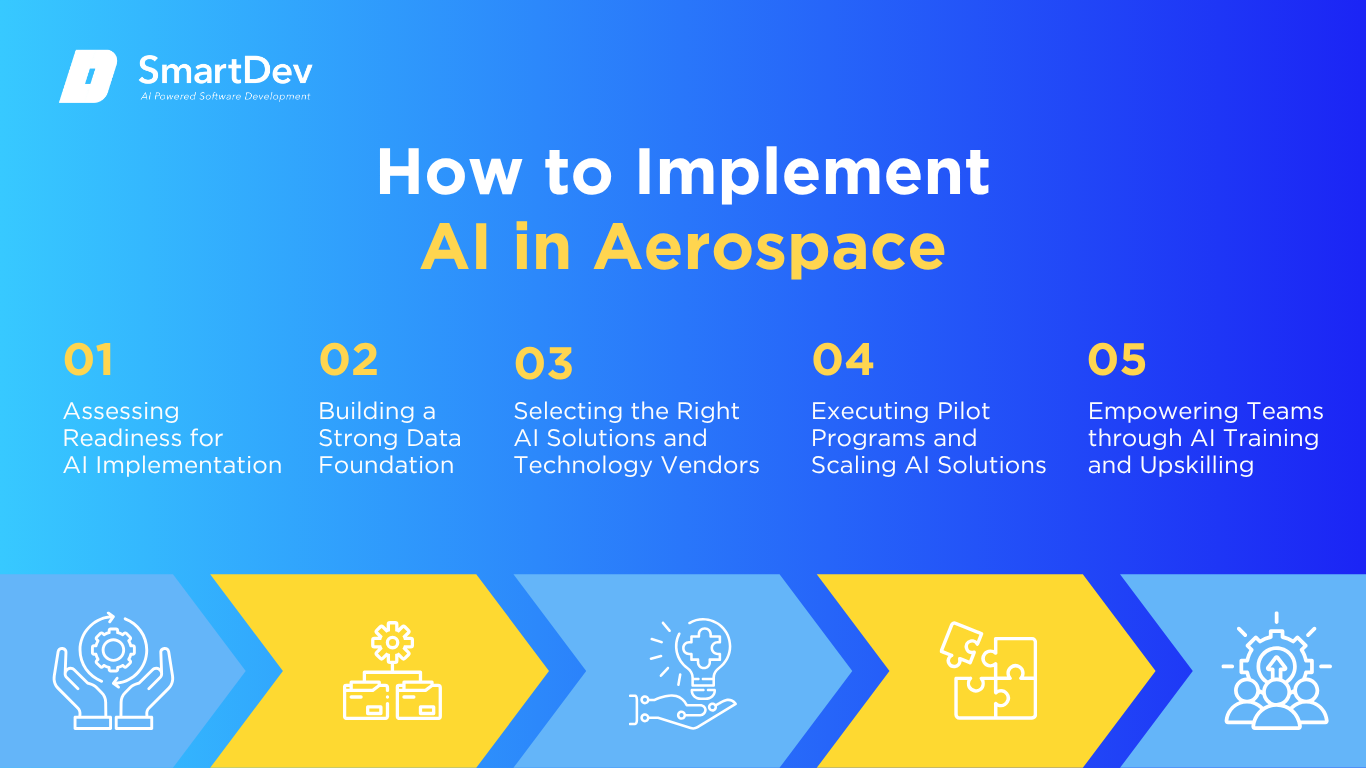
Step 1: Assessing Readiness for AI Adoption
Before integrating AI, take a close look at your organization’s operational maturity and digital infrastructure. Focus on areas where inefficiencies are frequent, such as maintenance scheduling, part inspections, or inventory forecasting. These pain points are ideal for AI pilots because they offer quick wins and measurable improvements.
It is also important to evaluate your organization’s openness to technological change. Implementing AI frequently necessitates reengineering legacy systems and revisiting established workflows, particularly within the highly regulated aerospace sector. Securing early alignment and commitment from leadership and engineering teams is essential to building a strong foundation for successful adoption.
For engineering leaders driving AI adoption, this AI playbook for tech leads provides actionable strategies.
Step 2: Building a Strong Data Foundation
AI tools are only as good as the data that powers them. In aerospace, this means ensuring data from sensors, inspections, and operational logs is consistent, well-labeled, and stored in accessible formats. A unified data framework allows AI to detect patterns, predict failures, and simulate outcomes with precision.
It’s also essential to prioritize data governance and quality controls from the start. Standardizing inputs across departments, whether from MRO records or digital twins, helps avoid discrepancies that could lead to unreliable outputs. Clean data translates directly into safer operations and smarter decision-making.
Step 3: Choosing the Right Tools and Vendors
Adopting AI in aerospace isn’t about chasing the most advanced platform, it’s about finding the right fit for your operational needs. Choose vendors who understand the compliance-heavy nature of aerospace and offer scalable solutions for specific tasks like predictive maintenance or flight optimization. Seamless integration with your existing systems should be a baseline requirement.
Be sure to vet how these tools handle sensitive data. In aerospace, data privacy, IP control, and auditability are non-negotiables. The right partner will offer not just a capable platform, but also the transparency and support you need to maintain trust across your organization.
Discover how effective AI model training ensures accuracy, scalability, and performance in mission-critical sectors.
Step 4: Pilot Testing and Scaling Up
Start small by targeting one use case with clear ROI potential. Predictive engine maintenance or automated visual inspections are often strong candidates because they impact uptime and safety directly. Pilots provide the evidence needed to justify broader investment and identify any process gaps before scaling.
Review results thoroughly before moving forward. Analyze maintenance savings, uptime improvements, or inspection speeds to quantify gains. Once validated, scale in phases to minimize disruption while maximizing long-term value.
Step 5: Training Teams for Successful Implementation
Technology adoption only works when people are prepared to use it. Train technicians, engineers, and planners not just on how to use AI tools, but on how to interpret their insights. Framing AI as a co-pilot rather than a replacement helps reduce resistance and boost confidence.
Create opportunities for teams to collaborate and learn from each other. When operational staff and data experts work side-by-side, you foster a culture of innovation grounded in practical application. This cross-functional fluency will be key to sustaining and expanding your AI capabilities.
Measuring the ROI of AI in Aerospace
Key Metrics to Track Success
Measuring ROI in aerospace AI begins with operational KPIs such as aircraft availability, unscheduled maintenance reduction, and mean time between failures. These indicators reflect real-world impacts on fleet reliability and safety, key drivers of cost control and customer trust. Fuel savings per flight and emissions reduction also reveal how AI contributes to environmental and financial goals.
In manufacturing, AI performance is tracked through faster inspection times, lower defect rates, and improved part throughput. These metrics highlight how automation accelerates production while maintaining quality standards. Financially, maintenance cost reduction, labor hour savings, and improved asset utilization offer concrete ROI indicators.
Case Studies Demonstrating ROI
Qantas’s AI system, Constellation, reduced fuel usage by 2%, translating to $92 million in annual savings – proving that even small efficiency gains have massive financial upside. This initiative also contributed to carbon emission reductions, aligning cost savings with sustainability efforts. It exemplifies how AI can create dual value across operational and environmental metrics.
GE Aerospace’s partnership with Palantir improved maintenance forecasting for military jets, helping avoid delays in training operations. Their AI solutions also cut commercial engine maintenance lead-time by 60%, reducing aircraft downtime and boosting revenue continuity. Though financial data remains private, the operational improvements signal strong ROI from predictive analytics.
Common Pitfalls and How to Avoid Them
Aerospace companies often stall in the pilot phase due to vague goals and lack of internal alignment. To move forward, firms must prioritize impactful use cases and secure leadership support from day one. A clear strategy ensures AI pilots evolve into scalable deployments with measurable outcomes.
Poor data quality is another barrier, as inconsistent or siloed inputs undermine AI accuracy. Investing early in data integration and governance prevents downstream issues and supports regulatory compliance. Without clean data, even the best algorithms won’t yield reliable or actionable insights.
Resistance to AI adoption also slows ROI realization. Employees may distrust AI or fear job displacement, hindering usage. Building trust through transparency, training, and human-in-the-loop models ensures that teams see AI as a collaborator, not a competitor.
Future Trends of AI in Aerospace
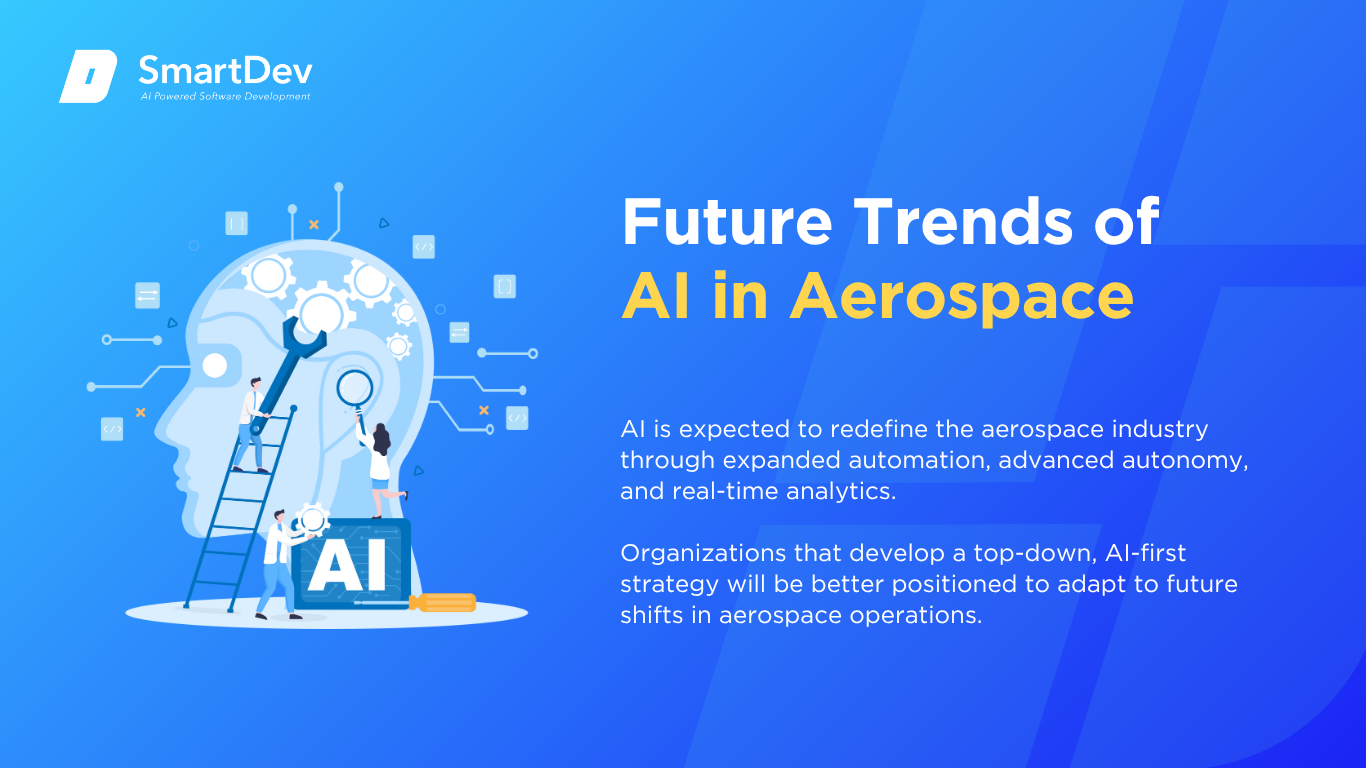
Predictions for the Next Decade
AI is expected to redefine the aerospace industry through expanded automation, advanced autonomy, and real-time analytics. Autonomous inspection robots and drone systems are anticipated to become standard, significantly reducing the time and labor associated with traditional manual inspections. Simultaneously, digital twins will evolve into dynamic systems that continuously ingest real-world data to support predictive maintenance and virtual certification processes.
Sustainability will remain a central driver for AI innovation in aerospace. AI-powered flight planning, airspace coordination, and fuel optimization will become critical tools in meeting stricter emissions targets and reducing operational costs. The convergence of environmental and economic benefits will further accelerate AI adoption across commercial and defense sectors.
How Businesses Can Stay Ahead of the Curve
Organizations that develop a top-down, AI-first strategy will be better positioned to adapt to future shifts in aerospace operations. Emphasis should be placed on solutions that improve user outcomes and operational efficiency, rather than solely focusing on backend infrastructure. Strategic partnerships with vendors who understand aerospace-specific regulatory and security challenges will be essential to scale AI effectively.
Continued investment in cybersecurity and AI governance will be critical as systems become more autonomous and interconnected. Robust safeguards, model transparency, and compliance with safety standards must be built into every AI deployment. In parallel, fostering an AI-literate workforce will ensure the human expertise needed to manage, interpret, and refine these technologies remains integral to the industry’s long-term success.
Conclusion
Key Takeaways
AI is transforming aerospace by enhancing design, manufacturing, maintenance, and operational efficiency. Technologies like generative AI, computer vision, and predictive analytics are delivering measurable gains in speed, accuracy, and cost reduction. These advancements also support broader goals around sustainability and regulatory compliance.
Proven results, such as reduced fuel use and faster maintenance cycles, demonstrate AI’s strong return on investment. However, realizing its full potential requires clear strategy, quality data, and cross-functional alignment. Organizations that take a thoughtful, structured approach will be best positioned to lead the industry’s next era of innovation.
Moving Forward: A Strategic Approach to AI-Driven Transformation
As AI reshapes the aerospace industry, the opportunity to optimize operations, reduce costs, and enhance system reliability has never been more accessible. From predictive maintenance and autonomous inspections to fuel optimization and digital twin simulations, AI is becoming a strategic imperative for organizations aiming to stay ahead in a highly competitive, regulation-driven sector.
At SmartDev, we provide customized AI solutions tailored to the specific challenges and requirements of the aerospace industry. Our experts collaborate closely with stakeholders to implement scalable technologies that improve performance, increase safety, and drive measurable ROI across engineering, maintenance, and operational workflows.
Explore our AI-powered software development services to see how we build intelligent solutions tailored to your aerospace software lifecycle from concept design to mission-critical continuous delivery.
Contact us today to learn how AI can elevate aerospace capabilities and help future-proof operations in a rapidly evolving technological landscape.
—
References:
- Is AI Cleared For Takeoff In The Aerospace Industry? | Forbes
- Artificial Intelligence and Robotics in Aerospace & Defense | GlobeNewswire
- GVR Report cover AI In Aerospace And Defense Market Size, Share & Trends Analysis Report | Grand View Research
- AI in Aerospace and Defense Market Size, Share and Trends 2024 to 2034 | Precedence Research
- The future of AI in the aerospace industry | DXC Technology
- AI-Powered Augmented Reality for Satellite Assembly, Integration and Test | arXiv
- The application of reasoning to aerospace Integrated Vehicle Health Management (IVHM): Challenges and opportunities | ScienceDirect
- Autonomous Aircraft Sequencing and Separation with Hierarchical Deep Reinforcement Learning | Aerospace Engineering at Iowa State University
- Selected Artificial Intelligence Methods Applied within an Integrated Vehicle Health Management System | The Association for the Advancement of Artificial Intelligence
- NoamAI unveils AI system to support air traffic controllers | Military Aerospace
- AI @ GE Aerospace | GE Aerospace
- How AI is increasing readiness in aerospace and defense industry | Axios
- Three Truths About AI in Aerospace and Defense | Boston Consulting Group







